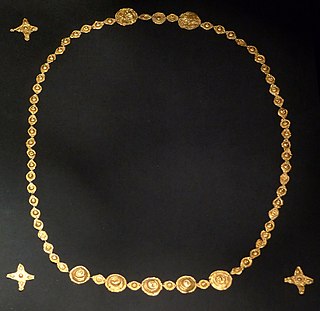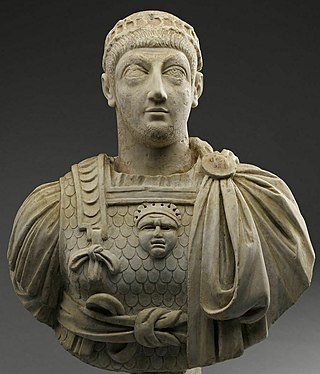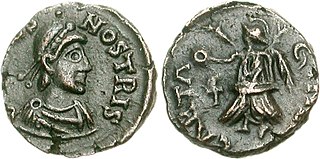
Huneric,Hunneric or Honeric was King of the Vandal Kingdom (477–484) and the oldest son of Gaiseric. He abandoned the imperial politics of his father and concentrated mainly on internal affairs. He was married to Eudocia, daughter of western Roman Emperor Valentinian III (419–455) and Licinia Eudoxia. The couple had one child, a son named Hilderic.

The Vandals were a Germanic people who first inhabited what is now southern Poland. They established Vandal kingdoms on the Iberian Peninsula, Mediterranean islands, and North Africa in the fifth century.

Anicius Olybrius was Roman emperor from July 472 until his death later that same year; his rule as Augustus in the western Roman Empire was not recognised as legitimate by the ruling Augustus in the eastern Roman Empire, Leo I. He was in reality a puppet ruler raised to power by Ricimer, the magister militum of Germanic descent, and was mainly interested in religion, while the actual power was held by Ricimer and his nephew Gundobad.

Valentinian III was Roman emperor in the West from 425 to 455. Made emperor in childhood, his reign over the Roman Empire was one of the longest, but was dominated by powerful generals vying for power amid civil wars and the invasions of Late antiquity's Migration Period, including the campaigns of Attila the Hun.

Basiliscus was Eastern Roman emperor from 9 January 475 to August 476. He became magister militum per Thracias in 464, under his brother-in-law, Emperor Leo I. Basiliscus commanded the army for an invasion of the Vandal Kingdom in 468, which was defeated at the Battle of Cape Bon. There were accusations at the time that Basiliscus was bribed by Aspar, the magister militum; many historians dismiss this, instead concluding that Basiliscus was either incompetent or foolish for accepting Vandal King Gaiseric's offer of a truce, which the latter used to construct fireships. Basiliscus's defeat cost the Eastern Empire 130,000 pounds (59,000 kg) of gold, causing the empire to hover above bankruptcy for 30 years. When Basiliscus returned to Constantinople, he sought refuge in the Church of St. Sophia. His sister, Empress Verina, secured him a pardon and he left the church to retire in Neapolis.

The term Western Roman Empire is used in modern historiography to refer to the western provinces of the Roman Empire, collectively, during any period in which they were administered separately from the eastern provinces by a separate, independent imperial court. Particularly during the period from 395 to 476 AD, there were separate, coequal courts dividing the governance of the empire into the Western provinces and the Eastern provinces with a distinct imperial succession in the separate courts. The terms Western Roman Empire and Eastern Roman Empire were coined in modern times to describe political entities that were de facto independent; contemporary Romans did not consider the Empire to have been split into two empires but viewed it as a single polity governed by two imperial courts for administrative expediency. The Western Empire collapsed in 476, and the Western imperial court in Ravenna disappeared by 554 AD, at the end of Justinian's Gothic War.

Bonifatius was a Roman general and governor of the diocese of Africa. He campaigned against the Visigoths in Gaul and the Vandals in North Africa. An ally of Galla Placidia, mother and advisor of Valentinian III, Bonifacius engaged in Roman civil wars on her behalf against the generals Felix in 427-429 and Aetius in 432. Although he defeated the latter at the Battle of Rimini, Bonifacius suffered a fatal wound and was succeeded by his son-in-law Sebastianus as patricius of the Western Roman Empire.

Licinia Eudoxia was a Roman Empress, daughter of Eastern Roman Emperor Theodosius II. Her husbands included the Western Roman Emperors Valentinian III and Petronius Maximus.
Victor of Tunnuna was Bishop of the North African town of Tunnuna and a chronicler from Late antiquity. He was also considered a martyr by Isidore of Seville.

Libius Severus, sometimes enumerated as Severus III, was emperor of the Western Roman Empire from 461 to his death in 465. A native of Lucania, Severus was the fourth of the so-called Shadow Emperors who followed the deposition of the Valentinianic dynasty in 455. He ruled for just under four years, attaining the throne after his predecessor, Majorian, was overthrown by his magister militum, Ricimer. Severus was the first of a series of emperors who were highly dependent on the general, and it is often presumed that Ricimer held most of the de facto power during Severus' reign
Heremigarius was a Suevic military leader operating in Lusitania in the early fifth century. He may have been a joint monarch with Hermeric or his successor, but no primary source directly attests it. Writing in the mid-seventh century, Fredegar calls Heremigarius rex Suaevorum, king of the Suevi.
Flavius Celer was a Byzantine general and magister officiorum under Emperor Anastasius in the early 6th century.
Gaiseric, also known as Geiseric or Genseric was king of the Vandals and Alans from 428 to 477. He ruled over a kingdom and played a key role in the decline of the Western Roman Empire during the 5th century.

December 15 - Eastern Orthodox liturgical calendar - December 17

November 12 - Eastern Orthodox liturgical calendar - November 14

The Vandal Kingdom or Kingdom of the Vandals and Alans was a confederation of Vandals and Alans, which is one of the barbarian kingdoms established under Gaiseric, a Vandal warrior. It ruled in North Africa and the Mediterranean from 435 to 534 AD.
Honoratus Antoninus was a bishop of Constantine (Cirta) in the Roman province of Africa. He was alive during the persecution of the Catholics by the Vandal king Gaiseric in the 5th century, around the year 437.

The Mauro-Roman kingdom, also described as the kingdom of Masuna, was a Christian Berber kingdom which dominated much of the ancient Roman province of Mauretania Caesariensis from the capital city of Altava. Scholars are in disagreement about whether the polity aimed for independence as a kingdom or was part of a loose confederation, an alternative hypothesis drawn from contextual knowledge about Berber tribal alliances. In the fifth century, Roman control over the province weakened and Imperial resources had to be concentrated elsewhere, notably in defending the Roman Italy itself from invading Germanic tribes. Moors and Romans in Mauretania came to operate independently from the Empire. However, regional leaders may not have necessarily felt abandoned by the Romans.

The Kingdom of the Aurès was an independent Christian Berber kingdom primarily located in the Aurès Mountains of present-day north-eastern Algeria. Established in the 480s by King Masties following a series of Berber revolts against the Vandalic Kingdom, which had conquered the Roman province of Africa in 435 AD, Aurès would last as an independent realm until the Muslim conquest of the Maghreb in 703 AD when its last monarch, Queen Dihya, was slain in battle.
← November 9 | November 10 | November 11 →